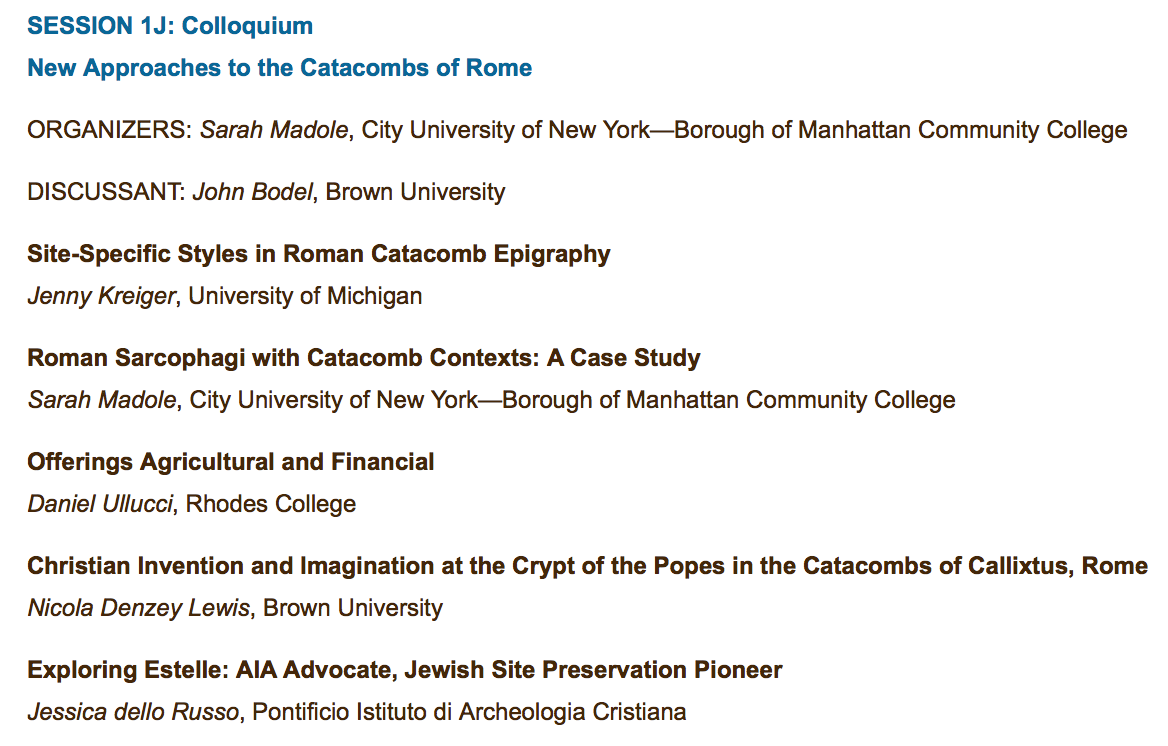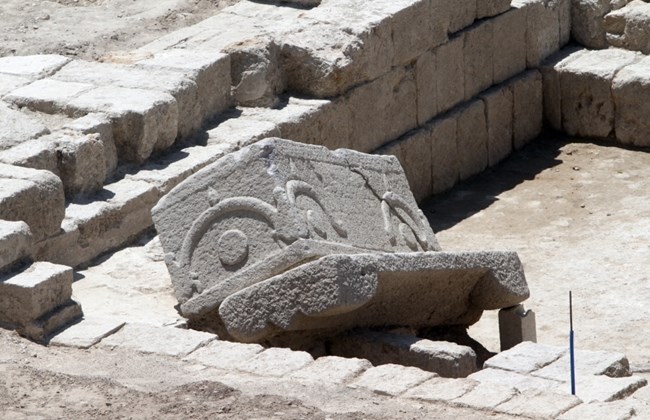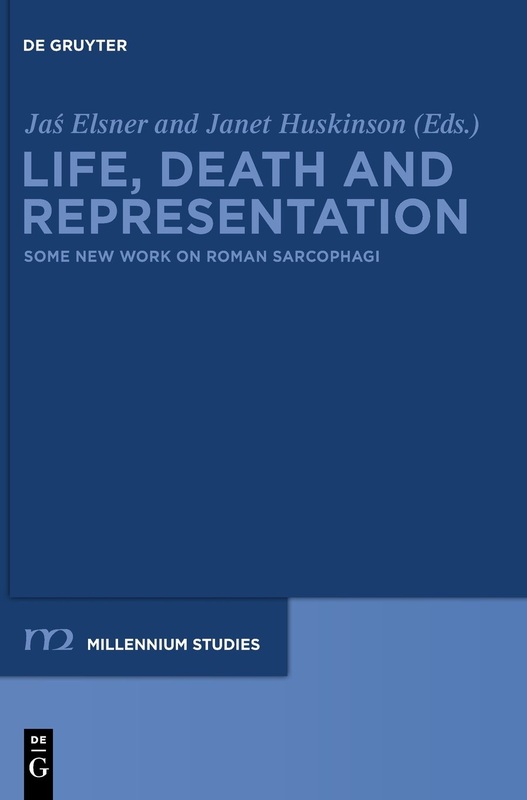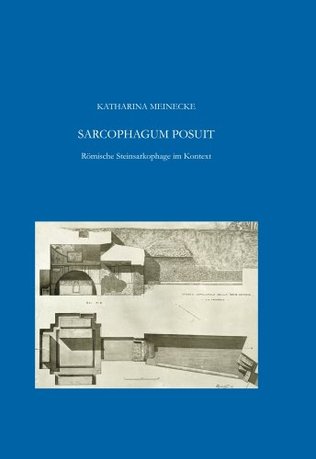|
Sarah Madole, of CUNY, will be giving a paper at the upcoming 2018 Annual Meeting of the Archaeological Institute of America.
The title: "Roman Sarcophagi with Catacomb Contexts: A Case Study". The paper will be delivered in Session 1J — New Approaches to the Catacombs of Rome — of which she is also the organizer and Chair. Scheduled for Friday, January 5, 8:00 - 10:30 am, the session also features papers by Nicola Denzey Lewis, Jenny Kreiger, Daniel Ullucci, and Jessica dello Russo, with concluding response/discussion by the formidable John Bodel. Not to be missed. As just reported by the BBC, a Roman sarcophagus was uncovered last month at a construction site on Swan Street, near Borough Market, in central London. It was found within a fourth-century mausoleum occupying prime real estate: directly beside the main road into the city, always the most desirable location in any Roman town's funerary landscape. The sarcophagus itself — only the second such ever discovered in London — has not yet been fully freed from the dirt, so its decoration is yet unknown. Initial tests with a metal detector, however, indicate the presence of small metal objects within, raising hopes that some grave goods may have survived. Romania's Nine O'Clock reports the discovery — the first ever — of a Roman sarcophagus at ancient Porolissum, capital of Dacia Porolissensis.
The limestone chest and lid apparently lack adornment and are clearly unfinished. Judging from the lid's four corner acroterial projections and its double-pitched roof, however, the carver was following eastern rather than metropolitan Roman models. This choice might seem a bit unexpected for a Latin-speaking province — but is perhaps less surprising in light of Porolissensis's Transylvanian location and proximity to eastern centers. The large notch cut in the lid, showing signs of discoloration, is intriguing. Perhaps a sign of reuse? Reuse might also account for the coffin's unusual find spot: not in the town's necropolis outside the Roman castrum, but rather "within the sacred area". (of Liber Pater? of Nemesis? We're not told.) Lebanon's Daily Star reports the excavation of a Roman sarcophagus, as well as remnants of an ancient well, at a construction site in Sidon's Bustan al-Kabir neighborhood. From the photograph below the sarcophagus appears to be of standard eastern garland type, pressed into service as a blank.
Two burial grounds, yielding skeletons, pottery, and coins with Latin inscriptions, were found at the same site a month ago. The relationship of the sarcophagus and the burials to the well has not yet been clarified. A new article by Esen Öğüş — one of only a handful to address Asian sarcophagi — recently appeared in the AJA. It presents, in accessible form, some of the most important conclusions of her doctoral thesis.
The full reference: Esen Öğüş, "Columnar Sarcophagi from Aphrodisias: Elite Emulation in the Greek East", American Journal of Archaeology 118, no. 1 (January 2014): 113-36. To my knowledge, the last 23 years have seen only four (!) American dissertations devoted to Roman sarcophagi. The good news is that all four were filed within the last five years, reflecting surging interest among English-speaking scholars in a field traditionally dominated by German scholarship.
Of these four dissertations, three focus on Asian sarcophagi, taking advantage of the wealth of material unearthed at Roman Aphrodisias. The first, by Esen Öğüş, explores the socio-cultural significance of columnar sarcophagi within both their local Aphrodisian context and broader patterns of burial in Asia Minor. The full reference: Esen Öğüş, Columnar Sarcophagi from Aphrodisias: Construction of Elite Identity in the Greek East, Harvard University, 2010. Abstract (courtesy of the author): This thesis explores the social and cultural meaning of a specific group of marble sarcophagi from Aphrodisias in Caria. The columnar sarcophagi, a corpus of 212 fully preserved or fragmentary pieces, are decorated on chests with projecting columns forming aediculae for the display of standing human figures in relief. Funerary inscriptions inform us that the majority of the Aphrodisian sarcophagi date to the third century A.D. and did not belong to the traditional city elite known from honorary inscriptions in the first two centuries A.D., but to a class of artisans and tradesmen who were newly granted citizenship by Caracalla’s Edict in A.D. 212. Part I of the thesis, drawing evidence from epigraphic analysis, situates the columnar sarcophagi within their archaeological context, and clarifies aspects of sarcophagus use in the city of Aphrodisias. Part II classifies and presents the extant corpus in three groups by highlighting the significance of each. Part III interprets the material within both the local cultural context and the widespread burial culture of Asia Minor. The iconography of the columnar sarcophagi, featuring human figures that exhibit paideia, reflects two sets of influences on the local culture: the ideals of the Second Sophistic; and the honorific habit that commemorated the good deeds of wealthy elite citizens. The overall appearance of a sarcophagus chest resembles a public building with a columnar façade and honorific statues embedded in it. Therefore, by commissioning columnar sarcophagi, the sub-elite patrons owned a personal model of a public building with their small-scale portrait statues on its façade. Since the ownership of a public statue was a privilege that the people of this status never had the chance to enjoy in life, they adapted conventions of private funerary art to avail themselves of a similar privilege in death. Exploring the social meaning of other local groups of sarcophagi in Asia Minor reveals that new citizens elsewhere developed their own local iconography in the third century that centered on their self-presentation and aspirations to elite status.
- Jaś Elsner, "Introduction".
|
Roman
|






